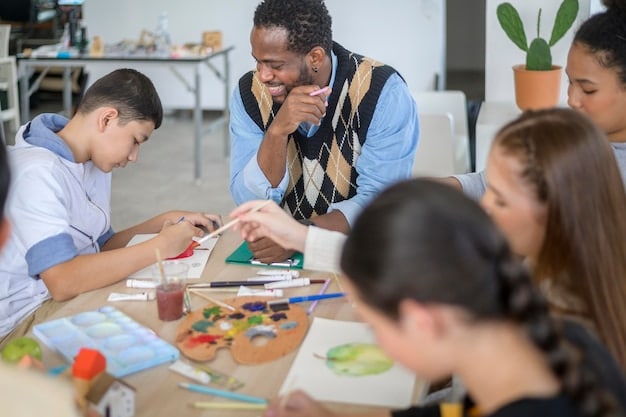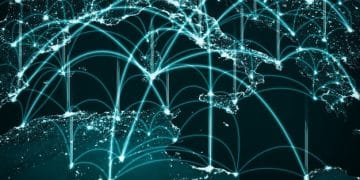US STEM Education Gap: Initiatives to Catch Up

The United States faces challenges in STEM education, prompting a range of initiatives focused on early exposure, curriculum enhancement, teacher development, and inclusive access to cultivate a competitive future workforce.
The landscape of global innovation is increasingly defined by proficiency in science, technology, engineering, and mathematics (STEM). For decades, the United States has been a beacon of scientific advancement and technological prowess. However, a growing concern suggests that the US is falling behind in STEM education: what initiatives are being implemented to catch up? This question is not merely academic; it is critical for maintaining economic competitiveness, national security, and addressing complex global challenges.
Understanding the STEM Education Gap in the US
The perception that the US is lagging in STEM education is not entirely new, but it has gained significant traction in recent years, fueled by international comparisons and workforce demands. While American universities continue to attract top talent globally, the pipeline of American-born STEM professionals often appears insufficient to meet the nation’s evolving needs. This gap is multifaceted, encompassing issues from K-12 foundational learning to higher education and workforce readiness.
Key Indicators of the Gap
Several indicators highlight the challenges within US STEM education. International assessments, such as the Program for International Student Assessment (PISA), often show US students performing at or below the average in science and mathematics compared to their peers in other developed nations. This trend suggests a foundational disconnect that can impact future STEM pursuits.
- PISA Scores: Consistent mid-range or lower performance in mathematics and science for US 15-year-olds.
- Workforce Shortages: Persistent vacancies in STEM fields, particularly in areas like artificial intelligence, cybersecurity, and advanced manufacturing.
- Lack of Diversity: Underrepresentation of women and minorities in many STEM disciplines, signaling untapped potential.
- Teacher Preparedness: Challenges in recruiting and retaining highly qualified STEM educators, especially in underserved areas.
The implications of this gap are far-reaching. A shortfall in STEM talent can stifle innovation, slow economic growth, and even compromise national security in a world increasingly reliant on technological superiority. Addressing these indicators requires a concerted effort across various sectors, from government and education to industry and communities.
Early Childhood and K-12 STEM Foundations
The journey towards a robust STEM workforce begins long before college. Early childhood and K-12 education play a pivotal role in shaping students’ interest, confidence, and foundational skills in STEM. Recognizing this, numerous initiatives are targeting these crucial developmental stages, aiming to cultivate a lifelong passion for discovery and problem-solving.
Innovations in K-12 Curriculum
Modern STEM education in K-12 is moving beyond traditional rote learning, emphasizing hands-on, inquiry-based approaches. New curricula are designed to make STEM concepts relatable and engaging, often integrating real-world applications and interdisciplinary connections. This shift aims to foster critical thinking, creativity, and collaborative skills from an early age, preparing students for the complexities of future STEM careers.
- Next Generation Science Standards (NGSS): Emphasize scientific practices and crosscutting concepts, moving beyond mere memorization.
- Computational Thinking Integration: Introducing coding and algorithmic thinking even in elementary grades.
- Project-Based Learning (PBL): Engaging students in long-term projects that require research, problem-solving, and collaboration.
- Makerspaces: Providing creative environments equipped with tools for hands-on design and prototyping.
Beyond specific curricula, there’s a growing recognition of the importance of informal learning environments. Science museums, after-school programs, and community workshops contribute significantly to sparking and nurturing STEM interest. These spaces offer alternative avenues for exploration and discovery, often in less structured and more playful settings, which can be particularly effective for younger children.
Enhancing Teacher Development and Support
Even the most innovative curricula and resources are ineffective without highly skilled and passionate educators. The quality of STEM instruction is directly linked to student outcomes. Consequently, a significant focus of current initiatives is on enhancing teacher development, providing ongoing professional learning, and creating supportive environments that attract and retain top talent in STEM fields.
Professional Development Programs
Many programs are dedicated to improving the pedagogical content knowledge of STEM teachers. These initiatives often offer workshops, intensive summer institutes, and online courses that focus on both deep subject matter understanding and effective teaching strategies. The goal is to equip teachers with the skills to deliver engaging, inquiry-based STEM lessons that cater to diverse learning styles.
- STEM Teacher Pipeline Programs: Scholarships and stipends for aspiring STEM teachers.
- Ongoing Professional Learning: Workshops on new technologies, pedagogical approaches, and content updates.
- Mentorship Programs: Connecting new STEM teachers with experienced mentors for guidance and support.
- Industry Partnerships: Providing opportunities for teachers to gain real-world STEM experience through externships with companies.
Beyond initial training, continuous professional development is crucial. The fields of science and technology evolve rapidly, requiring educators to constantly update their knowledge and skills. Initiatives are also exploring ways to create stronger communities of practice among STEM teachers, allowing them to share best practices, collaborate on lesson plans, and collectively address challenges in their classrooms. This collaborative environment can significantly boost morale and effectiveness.
Broadening Participation and Inclusivity in STEM
A critical aspect of strengthening US STEM education involves ensuring that all students, regardless of their background, have access to high-quality STEM learning opportunities. Historically, certain groups have been underrepresented in STEM fields, including women, minorities, and students from low-income communities. Initiatives are now actively working to dismantle barriers and foster a more inclusive STEM ecosystem.
Targeted Outreach and Mentorship
To address issues of underrepresentation, many programs are specifically designed to reach out to minority groups and girls, encouraging their participation in STEM from an early age. These initiatives often involve role models, mentorship opportunities, and exposure to diverse STEM professionals, helping to break down stereotypes and build confidence.
- Girls in STEM Programs: Clubs, camps, and workshops specifically for young women to explore STEM careers.
- Minority STEM Scholarship Programs: Financial aid and support for underrepresented students pursuing STEM degrees.
- Community STEM Hubs: Local centers providing access to resources, tutoring, and hands-on activities in underserved areas.
- Diverse Role Models: Connecting students with successful STEM professionals from similar backgrounds.
Efforts to broaden participation also extend to addressing systemic inequities within educational institutions. This includes promoting equitable access to advanced STEM courses, creating supportive classroom environments, and implementing culturally responsive teaching practices. The aim is to ensure that every student feels a sense of belonging and sees a viable path for themselves in STEM, contributing to a more diverse and innovative workforce. Equity in access is paramount for long-term success.

Government and Industry Investments in STEM
Recognizing the national imperative, both the US government and private industries are making significant investments in STEM education. These collaborations are essential for providing the necessary funding, resources, and policy frameworks to support large-scale educational reforms and skill development that align with future workforce demands.
Federal Funding and Policy
Federal agencies like the National Science Foundation (NSF), the Department of Education, and NASA actively fund research, programs, and initiatives aimed at improving STEM education at all levels. These investments support everything from curriculum development to teacher training and research into effective teaching methodologies.
- NSF’s STEM Education Directorate: Funds research and development to improve STEM education at all levels.
- Department of Education Grants: Support for innovative STEM programs in schools and districts.
- NASA’s Education Programs: Inspiring next-generation explorers through space-related STEM activities.
- CHIPS and Science Act: Allocates significant funds for STEM research and workforce development, especially in semiconductors and AI.
Beyond direct funding, government policies play a crucial role in setting national priorities and frameworks for STEM education. Recent legislative acts, such as the CHIPS and Science Act, highlight a renewed commitment to strengthening the STEM pipeline, particularly in critical technological areas. These policies often aim to accelerate research, develop a skilled workforce, and maintain US leadership in key industries.
Industry involvement is equally vital. Many corporations invest in STEM education through philanthropic efforts, internships, and partnerships with educational institutions. They recognize that a skilled workforce is directly tied to their future success, leading them to actively participate in shaping educational outcomes. These collaborations help ensure that students are learning skills that are directly relevant to current and emerging industry needs.
Future Directions and Challenges
While significant strides are being made, the journey to fully address the STEM education gap in the US is ongoing. Future initiatives will need to continue adapting to rapidly changing technological landscapes and evolving economic demands. New challenges, such as the rise of artificial intelligence and automation, present both opportunities and necessities for further educational reform.
Preparing for Emerging Technologies
The pace of technological change means that STEM education must be agile and forward-looking. Curricula need to be updated regularly to include emerging fields like artificial intelligence, quantum computing, biotechnology, and sustainable energy. This requires a strong connection between educational institutions and industries to anticipate future skill requirements.
- AI and Data Science Literacy: Integrating basic AI concepts and data interpretation across disciplines.
- Interdisciplinary Approaches: Fostering connections between STEM fields and other areas like arts (STEAM) or humanities.
- Lifelong Learning Models: Developing pathways for continuous skill development and re-training for adults.
- Cybersecurity Education: Emphasizing digital literacy and cybersecurity awareness from early grades to higher education.
One of the persistent challenges remains equity of access. Bridging the digital divide and ensuring that all students have access to technology and high-speed internet is fundamental for modern STEM learning. Without equitable access, disparities in educational outcomes will persist, hindering the nation’s overall STEM capacity. Continued investment in infrastructure and resources for underserved communities will be paramount.

Furthermore, inspiring the next generation will require continuous efforts in public outreach and perception. Shifting cultural narratives around STEM, making it seem accessible and exciting for everyone, is critical. Highlighting the societal impact of STEM careers, from medical breakthroughs to climate solutions, can attract a broader and more diverse pool of talent. The future of US competitiveness and innovation hinges on these sustained and adaptive efforts.
| Key Area | Brief Description |
|---|---|
| 📚 K-12 Foundations | Focus on inquiry-based learning, NGSS, and early computational thinking to build core skills. |
| 👩🏫 Teacher Support | Investing in professional development and mentorship to enhance STEM teaching quality. |
| 🌍 Inclusivity & Diversity | Targeted outreach and programs to broaden participation for underrepresented groups. |
| 💰 Gov’t & Industry | Federal funding, policies, and private sector partnerships driving STEM workforce development. |
Frequently Asked Questions About US STEM Education
▼
The perception stems from various factors, including international assessment scores where US students often lag behind peers in other developed nations. Additionally, persistent shortages of skilled workers in rapidly evolving STEM fields highlight a gap between educational output and workforce demand, underscoring concerns about global competitiveness and innovation capacity.
▼
K-12 schools are foundational to addressing the STEM gap by fostering early interest and building essential skills. Initiatives focus on introducing hands-on, project-based learning and computational thinking from elementary grades. This early engagement is crucial for developing critical thinking, problem-solving abilities, and a sustained passion for STEM subjects throughout a student’s academic journey.
▼
Teacher development programs are vital for enhancing the quality of STEM instruction. They offer ongoing professional learning, workshops, and mentorship to equip educators with updated subject knowledge and effective teaching methodologies. This ensures teachers can deliver engaging, inquiry-based lessons, inspiring students and preparing them for future STEM challenges, which is critical for skill transfer.
▼
Initiatives to foster diversity in STEM include targeted outreach, scholarships, and mentorship programs for underrepresented groups such as women and minorities. These efforts aim to break down systemic barriers and stereotypes, provide access to resources, and create inclusive learning environments where all students feel welcome and see a clear path to success in various STEM careers.
▼
Both government agencies (like NSF and the Department of Education) and private industries are investing significantly in STEM education. Government funding supports research, programs, and policy frameworks, while industries provide internships, philanthropic contributions, and partnerships with educational institutions. This collaboration ensures alignment between educational outcomes and the skills demanded by the evolving workforce, critical for national prosperity.
Conclusion
The concern that the US is facing challenges in STEM education is well-founded, stemming from international comparisons and evolving workforce needs. However, a robust landscape of initiatives is actively working to bridge this gap. From strengthening early childhood and K-12 foundations with engaging curricula and enhanced teacher development, to broadening participation for underrepresented groups and securing substantial government and industry investments, the commitment to improving STEM education is clear. As the nation looks to the future, continued adaptability to emerging technologies and a persistent focus on equity will be critical to ensuring the US remains a global leader in innovation and scientific discovery.





